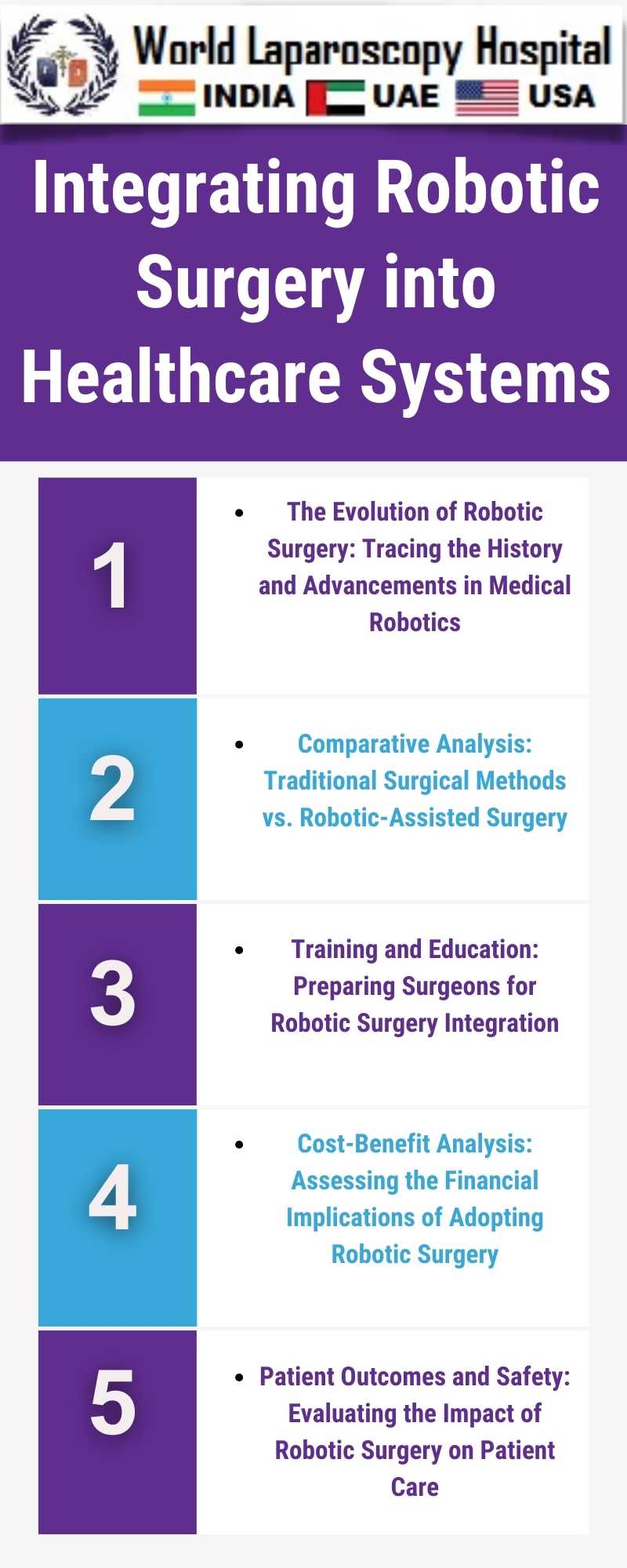Integrating Robotic Surgery into Healthcare Systems
Introduction
The advent of robotic surgery marks a significant milestone in the evolution of medical technology. This innovative approach integrates advanced robotic systems into surgical procedures, aiming to enhance the capabilities of surgeons and improve patient outcomes. This essay delves into the integration of robotic surgery into healthcare systems, examining its benefits, challenges, and potential future developments.

Background and Evolution
Robotic surgery, pioneered in the late 20th century, has evolved from a novel concept to a practical tool in various surgical fields. Initially developed to overcome limitations of minimally invasive surgery and enhance the precision of surgical procedures, robotic systems like the da Vinci Surgical System have become more common in operating rooms worldwide. These systems offer high-definition, three-dimensional visualization and instruments that mimic the movements of a surgeon’s hands, allowing for greater precision and control.
Benefits of Robotic Surgery
1. Enhanced Precision and Control: Robotic systems provide surgeons with superior visualization and dexterity, enabling more precise and less invasive procedures.
2. Reduced Trauma and Faster Recovery: Patients often experience less pain, reduced risk of infection, and quicker recovery times compared to traditional surgery.
3. Increased Accessibility to Complex Procedures: Robotic surgery makes complex procedures more feasible, potentially increasing the success rates of challenging surgeries.
Challenges in Integration
1. High Costs: The initial investment and maintenance costs of robotic systems are substantial, posing financial challenges for healthcare providers.
2. Training and Learning Curve: Surgeons require extensive training to master robotic systems, which can be time-consuming and resource-intensive.
3. Technological Limitations and Dependence: Over-reliance on technology and the potential for mechanical failures raise concerns about patient safety.
Future Prospects and Developments
The future of robotic surgery is promising, with ongoing research and development aimed at overcoming current limitations. Advancements may include enhanced artificial intelligence integration, improved tactile feedback, and smaller, more versatile robotic platforms. These innovations could lead to broader applications in surgery, making robotic procedures more accessible and efficient.
Conclusion
The integration of robotic surgery into healthcare systems represents a significant advancement in medical technology. While it offers numerous benefits, including enhanced precision and improved patient outcomes, it also presents challenges such as high costs and a steep learning curve. With continued innovation and adaptation, robotic surgery has the potential to become a standard in surgical practice, profoundly impacting the future of healthcare.
The advent of robotic surgery marks a significant milestone in the evolution of medical technology. This innovative approach integrates advanced robotic systems into surgical procedures, aiming to enhance the capabilities of surgeons and improve patient outcomes. This essay delves into the integration of robotic surgery into healthcare systems, examining its benefits, challenges, and potential future developments.

Background and Evolution
Robotic surgery, pioneered in the late 20th century, has evolved from a novel concept to a practical tool in various surgical fields. Initially developed to overcome limitations of minimally invasive surgery and enhance the precision of surgical procedures, robotic systems like the da Vinci Surgical System have become more common in operating rooms worldwide. These systems offer high-definition, three-dimensional visualization and instruments that mimic the movements of a surgeon’s hands, allowing for greater precision and control.
Benefits of Robotic Surgery
1. Enhanced Precision and Control: Robotic systems provide surgeons with superior visualization and dexterity, enabling more precise and less invasive procedures.
2. Reduced Trauma and Faster Recovery: Patients often experience less pain, reduced risk of infection, and quicker recovery times compared to traditional surgery.
3. Increased Accessibility to Complex Procedures: Robotic surgery makes complex procedures more feasible, potentially increasing the success rates of challenging surgeries.
Challenges in Integration
1. High Costs: The initial investment and maintenance costs of robotic systems are substantial, posing financial challenges for healthcare providers.
2. Training and Learning Curve: Surgeons require extensive training to master robotic systems, which can be time-consuming and resource-intensive.
3. Technological Limitations and Dependence: Over-reliance on technology and the potential for mechanical failures raise concerns about patient safety.
Future Prospects and Developments
The future of robotic surgery is promising, with ongoing research and development aimed at overcoming current limitations. Advancements may include enhanced artificial intelligence integration, improved tactile feedback, and smaller, more versatile robotic platforms. These innovations could lead to broader applications in surgery, making robotic procedures more accessible and efficient.
Conclusion
The integration of robotic surgery into healthcare systems represents a significant advancement in medical technology. While it offers numerous benefits, including enhanced precision and improved patient outcomes, it also presents challenges such as high costs and a steep learning curve. With continued innovation and adaptation, robotic surgery has the potential to become a standard in surgical practice, profoundly impacting the future of healthcare.
2 COMMENTS
Dr. Madhu Verma
#1
Jan 14th, 2024 10:05 am
Robotic surgery integration in healthcare is a major technological advance, offering benefits like enhanced precision and improved patient outcomes. Challenges include high costs and a learning curve. Continued innovation could establish robotic surgery as a standard, profoundly shaping the future of healthcare.
Dr. Amit Mathur
#2
Jan 21st, 2024 5:42 am
The integration of robotic surgery is a significant advancement in medical technology, offering benefits like enhanced precision and improved patient outcomes. Challenges include high costs and a steep learning curve. With ongoing innovation and adaptation, robotic surgery has the potential to become a standard in surgical practice, profoundly impacting the future of healthcare.
| Older Post | Home | Newer Post |


